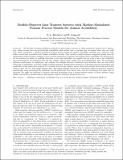Files in this item
Double-observer line transect surveys with Markov-modulated Poisson process models for animal availability
Item metadata
| dc.contributor.author | Borchers, David Louis | |
| dc.contributor.author | Langrock, Roland | |
| dc.date.accessioned | 2015-07-30T16:10:01Z | |
| dc.date.available | 2015-07-30T16:10:01Z | |
| dc.date.issued | 2015-12 | |
| dc.identifier | 103825914 | |
| dc.identifier | d2244efe-1266-46ef-9b50-d98e6ae03e22 | |
| dc.identifier | 84955351146 | |
| dc.identifier | 000368187300022 | |
| dc.identifier.citation | Borchers , D L & Langrock , R 2015 , ' Double-observer line transect surveys with Markov-modulated Poisson process models for animal availability ' , Biometrics , vol. 71 , no. 4 , pp. 1060-1069 . https://doi.org/10.1111/biom.12341 | en |
| dc.identifier.issn | 0006-341X | |
| dc.identifier.other | ORCID: /0000-0002-3944-0754/work/72842469 | |
| dc.identifier.uri | https://hdl.handle.net/10023/7085 | |
| dc.description.abstract | We develop maximum likelihood methods for line transect surveys in which animals go undetected at distance zero, either because they are stochastically unavailable while within view or because they are missed when they are available. These incorporate a Markov-modulated Poisson process model for animal availability, allowing more clustered availability events than is possible with Poisson availability models. They include a mark-recapture component arising from the independent-observer survey, leading to more accurate estimation of detection probability given availability. We develop models for situations in which (a) multiple detections of the same individual are possible and (b) some or all of the availability process parameters are estimated from the line transect survey itself, rather than from independent data. We investigate estimator performance by simulation, and compare the multiple-detection estimators with estimators that use only initial detections of individuals, and with a single-observer estimator. Simultaneous estimation of detection function parameters and availability model parameters is shown to be feasible from the line transect survey alone with multiple detections and double-observer data but not with single-observer data. Recording multiple detections of individuals improves estimator precision substantially when estimating the availability model parameters from survey data, and we recommend that these data be gathered. We apply the methods to estimate detection probability from a double-observer survey of North Atlantic minke whales, and find that double-observer data greatly improve estimator precision here too. | |
| dc.format.extent | 10 | |
| dc.format.extent | 455426 | |
| dc.language.iso | eng | |
| dc.relation.ispartof | Biometrics | en |
| dc.subject | Abundance estimation | en |
| dc.subject | Availability bias | en |
| dc.subject | Cox point process | en |
| dc.subject | Mark-recapture | en |
| dc.subject | Maximum likelihood | en |
| dc.subject | QA Mathematics | en |
| dc.subject | QH301 Biology | en |
| dc.subject | DAS | en |
| dc.subject | BDC | en |
| dc.subject | R2C | en |
| dc.subject.lcc | QA | en |
| dc.subject.lcc | QH301 | en |
| dc.title | Double-observer line transect surveys with Markov-modulated Poisson process models for animal availability | en |
| dc.type | Journal article | en |
| dc.contributor.sponsor | EPSRC | en |
| dc.contributor.institution | University of St Andrews. School of Mathematics and Statistics | en |
| dc.contributor.institution | University of St Andrews. Marine Alliance for Science & Technology Scotland | en |
| dc.contributor.institution | University of St Andrews. Scottish Oceans Institute | en |
| dc.contributor.institution | University of St Andrews. Centre for Research into Ecological & Environmental Modelling | en |
| dc.identifier.doi | 10.1111/biom.12341 | |
| dc.description.status | Peer reviewed | en |
| dc.identifier.grantnumber | EP/I000917/1 | en |
This item appears in the following Collection(s)
Items in the St Andrews Research Repository are protected by copyright, with all rights reserved, unless otherwise indicated.

